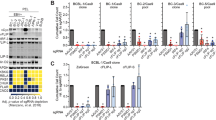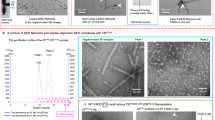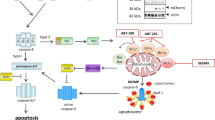Abstract
Members of the viral Flice/caspase-8 inhibitory protein (v-FLIP) family prevent induction of apoptosis by death receptors through inhibition of the processing and activation of procaspase-8 and -10 at the level of the receptor-associated death-inducing signaling complex (DISC). Here, we have addressed the molecular function of the v-FLIP member MC159 of the human molluscum contagiosum virus. MC159 FLIP powerfully inhibited both caspase-dependent and caspase-independent cell death induced by Fas. The C-terminal region of MC159 bound TNF receptor-associated factor (TRAF)3, was necessary for optimal TRAF2 binding, and mediated the recruitment of both TRAFs into the Fas DISC. TRAF-binding-deficient mutants of MC159 showed impaired inhibition of FasL-induced caspase-8 processing and Fas internalization, and had reduced antiapoptotic activity. Our findings provide evidence that a MC159/TRAF2/TRAF3 complex regulates a new aspect of Fas signaling, and identify MC159 FLIP as a molecule that targets multiple features of Fas-induced cell death.
Similar content being viewed by others
Log in or create a free account to read this content
Gain free access to this article, as well as selected content from this journal and more on nature.com
or
Abbreviations
- CTL:
-
cytotoxic T lymphocyte
- DD:
-
death domain
- DED:
-
death effector domain
- DISC:
-
death-inducing signaling complex
- FLIP:
-
Flice/caspase-8 inhibitory protein
- MCV:
-
molluscum contagiosum virus
- TNF:
-
tumor necrosis factor
- TRAF:
-
TNF receptor-associated factor
References
Chipuk JE and Green DR (2005) Opinion: do inducers of apoptosis trigger caspase-independent cell death? Nat. Rev. Mol. Cell. Biol. 6: 268–275
Jaattela M and Tschopp J (2003) Caspase-independent cell death in T lymphocytes. Nat. Immunol. 4: 416–423
Krammer PH (2000) CD95's deadly mission in the immune system. Nature 407: 789–795
Peter ME and Krammer PH (2003) The CD95(APO-1/Fas) DISC and beyond. Cell. Death Differ. 10: 26–35
Boatright KM, Renatus M, Scott FL, Sperandio S, Shin H, Pedersen IM, Ricci JE, Edris WA, Sutherlin DP, Green DR and Salvesen GS (2003) A unified model for apical caspase activation. Mol. Cell 11: 529–541
Donepudi M, Mac Sweeney A, Briand C and Grutter MG (2003) Insights into the regulatory mechanism for caspase-8 activation. Mol. Cell 11: 543–549
Chang DW, Xing Z, Capacio VL, Peter ME and Yang X (2003) Interdimer processing mechanism of procaspase-8 activation. EMBO J. 22: 4132–4142
Stennicke HR, Jurgensmeier JM, Shin H, Deveraux Q, Wolf BB, Yang X, Zhou Q, Ellerby HM, Ellerby LM, Bredesen D, Green DR, Reed JC, Froelich CJ and Salvesen GS (1998) Pro-caspase-3 is a major physiologic target of caspase-8. J. Biol. Chem. 273: 27084–27090
Scaffidi C, Fulda S, Srinivasan A, Friesen C, Li F, Tomaselli KJ, Debatin KM, Krammer PH and ßPeter ME (1998) Two CD95 (APO-1/Fas) signaling pathways. EMBO J. 17: 1675–1687
Li H, Zhu H, Xu CJ and Yuan J (1998) Cleavage of BID by caspase 8 mediates the mitochondrial damage in the Fas pathway of apoptosis. Cell 94: 491–501
Luo X, Budihardjo I, Zou H, Slaughter C and Wang X (1998) Bid, a Bcl2 interacting protein, mediates cytochrome c release from mitochondria in response to activation of cell surface death receptors. Cell 94: 481–490
Korsmeyer SJ, Wei MC, Saito M, Weiler S, Oh KJ and Schlesinger PH (2000) Pro-apoptotic cascade activates BID, which oligomerizes BAK or BAX into pores that result in the release of cytochrome c. Cell Death Differ. 7: 1166–1173
Li P, Nijhawan D, Budihardjo I, Srinivasula SM, Ahmad M, Alnemri ES and Wang X (1997) Cytochrome c and dATP-dependent formation of Apaf-1/caspase-9 complex initiates an apoptotic protease cascade. Cell 91: 479–489
Zou H, Li Y, Liu X and Wang B (1999) An APAF-1. cytochrome c multimeric complex is a functional apoptosome that activates procaspase-9. J. Biol. Chem. 274: 11549–11556
Acehan D, Jiang X, Morgan DG, Heuser JE, Wang X and Akey CW (2002) Three-dimensional structure of the apoptosome: implications for assembly, procaspase-9 binding, and activation. Mol. Cell 9: 423–432
Holler N, Zaru R, Micheau O, Thome M, Attinger A, Valitutti S, Bodmer J-L, Schneider P, Seed B and Tschopp J (2000) Fas triggers an alternative, caspase-8-independent cell death pathway using the kinase RIP as effector molecule. Nat. Immunol. 1: 489–495
Stanger BZ, Leder P, Lee TH, Kim E and Seed B (1995) RIP: a novel protein containing a death domain that interacts with Fas/APO-1 (CD95) in yeast and causes cell death. Cell. 81: 513–523
Moss B, Shisler J, Xiang Y and Senkevich TG (2000) Immune-defense molecules of Molluscum contagiosum virus, a human poxvirus. Trends Microbiol. 8: 473–477
Siegel RM, Chan FK, Chun HJ and Lenardo MJ (2000) The multifaceted role of Fas signaling in immune cell homeostasis and autoimmunity. Nat. Immunol. 1: 469–474
Tschopp J, Thome M, Hofmann K and Meinl E (1998) The fight of viruses against apoptosis. Curr. Opin. Genet. Dev. 8: 82–87
Everett H and McFadden G (2002) Poxviruses and apoptosis: a time to die. Curr. Opin. Microbiol. 5: 395–402
Thome M and Tschopp J (2001) Regulation of lymphocyte proliferation and death by FLIP. Nat. Rev. Immunol. 1: 50–58
Smith KJ, Yeager J and Skelton H (1999) Molluscum contagiosum: its clinical, histopathologic, and immunohistochemical spectrum. Int. J. Dermatol. 38: 664–672
Hu S, Vincenz C, Buller M and Dixit VM (1997) A novel family of viral death effector domain-containing molecules that inhibit both CD-95- and tumor necrosis factor receptor-1-induced apoptosis. J. Biol. Chem. 272: 9621–9624
Bertin J, Armstrong RC, Ottilie S, Martin DA, Wang Y, Banks S, Wang GH, Senkevich TG, Alnemri ES, Moss B, Lenardo MJ, Tomaselli KJ and Cohen JI (1997) Death effector domain-containing herpesvirus and poxvirus proteins inhibit both Fas-and TNFR1-induced apoptosis. Proc. Natl. Acad. Sci. U.S.A. 94: 1172–1176
Thome M, Schneider P, Hofmann K, Fickenscher H, Meinl E, Neipel F, Mattmann C, Burns K, Bodmer JL, Schroter M, Scaffidi C, Krammer PH, Peter ME and Tschopp J (1997) Viral FLICE-inhibitory proteins (FLIPs) prevent apoptosis induced by death receptors. Nature 386: 517–521
Shisler JL and Moss B (2001) Molluscum contagiosum virus inhibitors of apoptosis: the MC159 v-FLIP protein blocks Fas-induced activation of procaspases and degradation of the related MC160 protein. Virology 282: 14–25
Garvey TL, Bertin J, Siegel RM, Wang GH, Lenardo MJ and Cohen JI (2002) Binding of FADD and caspase-8 to molluscum contagiosum virus MC159 v-FLIP is not sufficient for its antiapoptotic function. J. Virol. 76: 697–706
Bugert JJ, Melquiot N and Kehm R (2001) Molluscum contagiosum virus expresses late genes in primary human fibroblasts but does not produce infectious progeny. Virus Genes 22: 27–33
Garvey T, Bertin J, Siegel R, Lenardo M and Cohen J (2002) The death effector domains (DEDs) of the molluscum contagiosum virus MC159 v-FLIP protein are not functionally interchangeable with each other or with the DEDs of caspase-8. Virology 300: 217–225
Chan FK, Shisler J, Bixby JG, Felices M, Zheng L, Appel M, Orenstein J, Moss B and Lenardo MJ (2003) A role for tumor necrosis factor receptor 2 (TNFR-2) and receptor-interacting protein (RIP) in programmed necrosis and anti-viral responses. J. Biol. Chem. 278: 51613–51621
Holler N, Tardivel A, Kovacsovics-Bankowski M, Hertig S, Gaide O, Martinon F, Tinel A, Deperthes D, Calderara S, Schulthess T, Engel J, Schneider P and Tschopp J (2003) Two adjacent trimeric Fas ligands are required for Fas signaling and formation of a death-inducing signaling complex. Mol. Cell. Biol. 23: 1428–1440
Arch RH, Gedrich RW and Thompson CB (1998) Tumor necrosis factor receptor-associated factors (TRAFs) – a family of adapter proteins that regulates life and death. Genes Dev. 12: 2821–2830
Liu X, Kim CN, Yang J, Jemmerson R and Wang X (1996) Induction of apoptotic program in cell-free extracts: requirement for dATP and cytochrome c. Cell 86: 147–157
Scaduto RC and Grotyohann LW (1999) Measurement of mitochondrial membrane potential using fluorescent rhodamine derivatives. Biophys. J. 76: 469–477
Algeciras-Schimnich A, Shen L, Barnhart BC, Murmann AE, Burkhardt JK and Peter ME (2002) Molecular ordering of the initial signaling events of CD95. Mol. Cell. Biol. 22: 207–220
Medema JP, Scaffidi C, Kischkel FC, Shevchenko A, Mann M, Krammer PH and Peter ME (1997) FLICE is activated by association with the CD95 death-inducing signaling complex (DISC). EMBO J. 16: 2794–2804
Kischkel FC, Lawrence DA, Tinel A, LeBlanc H, Virmani A, Schow P, Gazdar A, Blenis J, Arnott D and Ashkenazi A (2001) Death receptor recruitment of endogenous caspase-10 and apoptosis initiation in the absence of caspase-8. J. Biol. Chem. 276: 46639–46646
Murao LE and Shisler JL (2005) The MCV MC159 protein inhibits late, but not early, events of TNF-alpha-induced NF-kappaB activation. Virology 340: 255–264
He L, Grammer AC, Wu X and Lipsky PE (2004) TRAF3 forms heterotrimers with TRAF2 and modulates its ability to mediate NF-kB activation. J. Biol. Chem. 279: 55855–55865
Chung JY, Park YC, Ye H and Wu H (2002) All TRAFs are not created equal: common and distinct molecular mechanisms of TRAF-mediated signal transduction. J. Cell Sci. 115: 679–688
Wang CY, Mayo MW, Korneluk RG, Goeddel DV and Baldwin Jr AS (1998)NF-kappaB antiapoptosis: induction of TRAF1 and TRAF2 and c-IAP1 and c-IAP2 to suppress caspase-8 activation. Science 281: 1680–1683
Micheau O, Lens S, Gaide O, Alevizopoulos K and Tschopp J (2001) NF-kB signals induce the expression of c-FLIP. Mol. Cell. Biol. 21: 5299–5305
Chaudhary PM, Jasmin A, Eby MT and Hood L (1999) Modulation of the NF-kappa B pathway by virally encoded death effector domains-containing proteins. Oncogene 18: 5738–5746
Gil J, Rullas J, Alcami J and Esteban M (2001) MC159L protein from the poxvirus molluscum contagiosum virus inhibits NF-kappaB activation and apoptosis induced by PKR. J. Gen. Virol. 82: 3027–3034
Joazeiro CA and Weissman AM (2000) RING finger proteins: mediators of ubiquitin ligase activity. Cell 102: 549–552
VanArsdale TL, VanArsdale SL, Force WR, Walter BN, Mosialos G, Kieff E, Reed JC and Ware CF (1997) Lymphotoxin-beta receptor signaling complex: role of tumor necrosis factor receptor-associated factor 3 recruitment in cell death and activation of nuclear factor kappaB. Proc. Natl. Acad. Sci. U.S.A. 94: 2460–2465
Force WR, Cheung TC and Ware CF (1997) Dominant negative mutants of TRAF3 reveal an important role for the coiled coil domains in cell death signaling by the lymphotoxin-beta receptor. J. Biol. Chem. 272: 30835–30840
Wu MY, Wang PY, Han SH and Hsieh SL (1999) The cytoplasmic domain of the lymphotoxin-beta receptor mediates cell death in HeLa cells. J. Biol. Chem. 274: 11868–11873
Rothenberger S, Burns K, Rousseaux M, Tschopp J and Bron C (2003) Ubiquitination of the Epstein–Barr virus-encoded latent membrane protein 1 depends on the integrity of the TRAF binding site. Oncogene 22: 5614–5618
Bonifacino JS and Traub LM (2003) Signals for sorting of transmembrane proteins to endosomes and lysosomes. Annu. Rev. Biochem. 72: 395–447
Manning E, Pullen SS, Souza DJ, Kehry M and Noelle RJ (2002) Cellular responses to murine CD40 in a mouse B cell line may be TRAF dependent or independent. Eur. J. Immunol. 32: 39–49
Kataoka T, Budd RC, Holler N, Thome M, Martinon F, Irmler M, Burns K, Hahne M, Kennedy N, Kovacsovics M and Tschopp J (2000) The caspase-8 inhibitor FLIP promotes activation of NF-kappaB and Erk signaling pathways. Curr. Biol. 10: 640–648
Shu HB, Halpin DR and Goeddel DV (1997) Casper is a FADD- and caspase-related inducer of apoptosis. Immunity 6: 751–763
Chang DW, Xing Z, Pan Y, Algeciras-Schimnich A, Barnhart BC, Yaish-Ohad S, Peter ME and Yang X (2002) c-FLIP(L) is a dual function regulator for caspase-8 activation and CD95-mediated apoptosis. EMBO J. 21: 3704–3714
Micheau O, Thome M, Schneider P, Holler N, Tschopp J, Nicholson DW, Briand C and Grutter MG (2002) The long form of FLIP is an activator of caspase-8 at the Fas death-inducing signaling complex. J. Biol. Chem. 277: 45162–45171
Boatright KM, Deis C, Denault JB, Sutherlin DP and Salvesen GS (2004) Activation of caspases-8 and -10 by FLIP(L). Biochem. J. 382: 651–657
Thome M, Martinon F, Hofmann K, Rubio V, Steiner V, Schneider P, Mattmann C and Tschopp J (1999) Equine herpesvirus-2 E10 gene product, but not its cellular homologue, activates NF-kappaB transcription factor and c-Jun N-terminal kinase. J. Biol. Chem. 274: 9962–9968
Acknowledgements
We thank Daniel Legler, Fabio Martinon, Olivier Micheau and Pascal Schneider for discussions and comments on the manuscript. This work was supported by grants of the Swiss Cancer League and the Swiss National Science Foundation to M Thome and J Tschopp, by a research fellowship of the Deutsche Forschungsgesellschaft to M Thurau, and by an EMBO long-term fellowship to H Everett.
Author information
Authors and Affiliations
Corresponding author
Additional information
Edited by D Vaux
Supplementary Information accompanies the paper on Cell Death and Differentiation website (http://www.nature.com/cdd)
Supplementary information
Rights and permissions
About this article
Cite this article
Thurau, M., Everett, H., Tapernoux, M. et al. The TRAF3-binding site of human molluscipox virus FLIP molecule MC159 is critical for its capacity to inhibit Fas-induced apoptosis. Cell Death Differ 13, 1577–1585 (2006). https://doi.org/10.1038/sj.cdd.4401847
Received:
Revised:
Accepted:
Published:
Issue date:
DOI: https://doi.org/10.1038/sj.cdd.4401847
Keywords
This article is cited by
-
FADD regulates NF-κB activation and promotes ubiquitination of cFLIPL to induce apoptosis
Scientific Reports (2016)
-
Spatiotemporal pattern of TRAF3 expression after rat spinal cord injury
Journal of Molecular Histology (2014)
-
TRAF molecules in cell signaling and in human diseases
Journal of Molecular Signaling (2013)
-
Going up in flames: necrotic cell injury and inflammatory diseases
Cellular and Molecular Life Sciences (2010)



